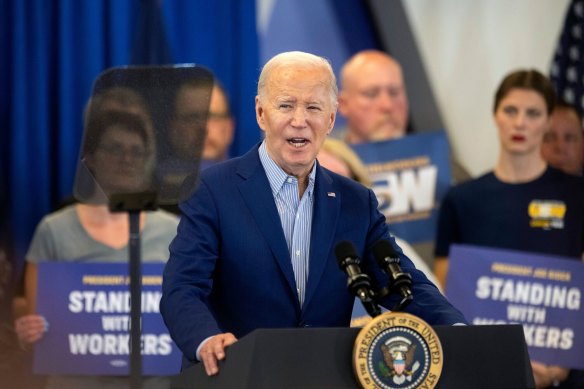
America’s steel industry has long been a protected sector, even though its production is less than half its peak decades ago and the sector’s technology has fallen well behind that of the Chinese, Japanese and South Koreans.
The very first tariffs Trump imposed on China (before he imposed tariffs on almost all US imports from China) were on steel and aluminium.
Protecting the jobs of US steelworkers via tariffs and subsidies comes at a significant cost to the economy, given that those companies that use steel as an input employ far more people in more productive industries.
Their increased costs ultimately flow through to higher prices for consumers, just as the cost of Trump’s $US360 billion-plus of tariffs on China’s exports were borne by US consumers rather than the exporters.
While there is an element of protectionism to Biden’s proposed increase in the steel tariffs – the US is a relatively modest importer of China’s steel – there is also a broader dimension to it. It forms a strand of a larger and wider concern in the US, Europe and elsewhere about the flow-on effects of China’s property sector crisis and slower domestic economic growth.
Investment in what was once a core driver of China’s growth has been falling steadily for nearly three years and is still declining – it has fallen by high single-digit rates in 11 of the past 12 months – and, with declining returns from further investment in infrastructure and no apparent desire to stoke consumption, Beijing has focused its economic strategy (and subsidies) on its factories.
With domestic demand having fallen away, significant excess capacity has emerged, resulting in a tide of cheap exports hitting global markets.

Biden and Trump’s opposition to Nippon Steel’s acquisition of US Steel highlights the domestic political sensitivities involved and how the US is prepared to treat even its close allies in the new paranoia over national self-sufficiency.Credit: Bloomberg
That’s the case within the steel industry, where domestic property development and infrastructure investment used to drive the billion-tonnes-a-year sector, accounting for about 55 per cent of the demand. Exports accounted for less than 10 per cent of the mills’ output.
With excess capacity increasing – China’s National Bureau of Statistics says the sector is operating at less than 78 per cent of its capacity – steel exports are rising rapidly. Exports of just over 90 million tonnes last year were more than 36 per cent higher than in 2022, and in the first quarter of this year were 25.8 million tonnes, so the run-rate is accelerating.
While the US and Europe aren’t major direct markets for China’s steel (the US imported less than 600,000 tonnes last year from China) both are complaining about the overinvestment and excess capacity within China’s industry generally while considering increased tariffs on imports of its metals.
The US is also concerned that China is exporting raw steel to third countries like Vietnam, Japan, India and Mexico, which is being turned into hot-rolled coil and other products that are then imported at lower duty rates or avoid being dutied at all.
Facing increased protectionism abroad, the steel mills – and China’s industrial sector more broadly – will need to be rationalised and its output reduced if they, and China’s mercantilist growth strategy, are to be sustainable, albeit diminished.
Other countries, including India and Mexico, Thailand, Vietnam, Chile and Brazil are also complaining about “dumping” of steel products and imposing, or threatening, their own tariffs.
If Trump wins re-election, he has said he will impose an extra 10 per cent tariff on all imports and a 60 per cent rate on imports from China.
The European Union’s Carbon Border Adjustment Mechanism (a tax on the embedded carbon in imports) comes into full force for steel imports in 2026, which will hit Chinese mills, among other exporters, because they largely use coal-fired plants.
The outlook, therefore, is for an increasingly less accommodating global market for the excess capacity in China’s industries, whether it’s steel or electric vehicles (where there’s also significant overproduction) or the broader range of consumer goods.

Joe Biden speaks at the United Steel Workers headquarters in Pittsburgh this week.Credit: Bloomberg
China produces more than half the world’s steel. If it can’t export most of the growing surplus to its domestic requirements, it would have significant implications for its domestic steel industry – and for Australia’s iron ore miners and federal and West Australian government revenues.
The South China Morning Post last week quoted a vice president of the China Iron and Streel Association, Tang Zujun, as saying that the era of large-scale construction in China was over, and in future would be driven by consumption and innovation-based strategic emerging industries.
“The biggest problem now is how to achieve a dynamic balance between supply and demand,” he said.
“If this problem is not handled well, it will have a huge impact on the ecosystem, sustainable development and international competitiveness of the entire industry.”
Loading
Facing increased protectionism abroad, the steel mills – and China’s industrial sector more broadly – will need to be rationalised and its output reduced if they, and China’s mercantilist growth strategy, are to be sustainable, albeit diminished.
The steel industry, because it is seen to have national security implications in this post-pandemic world of trade conflict and supply chain restructuring, is particularly vulnerable to the shift away from the globalisation of trade that has powered China’s economy for decades.
Biden’s opposition, with Trump’s, to Nippon Steel’s acquisition of US Steel highlights the domestic political sensitivities involved and how the US is prepared to treat even its close allies in the new paranoia over national self-sufficiency.
It won’t be the only nation to relegate the economics of trade to domestic politics and geopolitics, with China particularly vulnerable to any combination of those influences.
The Business Briefing newsletter delivers major stories, exclusive coverage and expert opinion. Sign up to get it every weekday morning.









 Add Category
Add Category